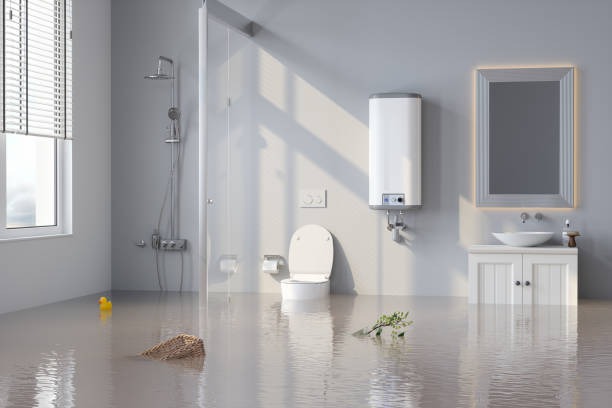When you find water seeping into your home, your immediate reaction might be panic. However, understanding the basics of water damage can help you stay calm. It often occurs due to events like leaking pipes, floods, or broken appliances. Knowing the source can significantly assist in promptly addressing the issue.
1. Spot the Source
For starters, it’s crucial to find where the water is coming from. It could be an overflowing bathtub, a burst pipe, or even rain seeping in through the roof. Once you identify the source, you can work towards stopping the influx.
-
Check appliances and plumbing for visible leaks.
-
Look at your roof and windows during rain to identify problem areas.
-
Don’t forget about your basement or crawl spaces.
2. Safety First
Your safety should always come first. Water and electricity are a dangerous mix, so approaching the situation with caution is necessary.
Turn Off Electricity
Before you step into water-logged areas, ensure the electricity in that part of the house is switched off. This helps prevent any risk of electric shock.
Protective Gear
Consider wearing protective gear, such as rubber boots and gloves, to safeguard yourself from contaminants in the water.
3. Document the Damage
Recording the extent of water damage early on is crucial for insurance purposes. Use your smartphone to take clear photos and videos of affected areas.
-
Capture images from various angles for the best coverage.
-
Don’t forget to include close-ups of significant damage.
-
Keep track of the initial and ongoing status as cleaning and repairs proceed.
4. Remove Excess Water
Removing water promptly can prevent further damage and reduce the risk of mold growth.
Simple Tools
Use buckets, mops, and towels to soak up standing water. If available, a wet/dry vacuum can be a lifesaver in extracting excess moisture.
Utilize Technology
Fans and dehumidifiers are excellent tools for speeding up the drying process. Place them strategically to circulate air in damp areas.
5. Inspect for Hidden Moisture
Don’t let hidden moisture catch you off guard. It’s easy to assume that only visible water is a problem, but lingering moisture can lead to major issues.
Look Under Carpets and Rugs
Carpets can trap moisture, so remember to check beneath them and consider lifting them for thorough drying.
Check Behind Walls
Water can seep behind walls, leading to mold growth. If you suspect this, contacting a professional might be your best option.
6. Dispose of Damaged Items
Unfortunately, not all items can be saved after a water damage event.
Sorting Belongings
Go through your belongings and decide what can be salvaged. Disposing of those things beyond repair is the healthiest choice.
Important Documents
For important papers, try using a freezer to temporarily halt water damage. Then, you can look into professional drying services.
7. Prevent Mold Growth
Mold can begin to grow within 24-48 hours of water exposure, so it’s essential to act quickly.
Use Mold Inhibitors
You can purchase mold inhibitors and apply them to damp surfaces. Regular cleaning with these solutions can help prevent spores from setting in.
Ensure Proper Ventilation
Open windows and run fans to help circulate air and reduce moisture levels indoors.
8. Seek Professional Help
Sometimes, the damage is beyond DIY measures, and you may need expert assistance. This is where services such as emergency restoration in Milton come into play. Professionals can evaluate the damage, offer solutions, and help mitigate further issues.
Consult Experienced Professionals
These experts can manage severe cases and perform tasks such as water extraction and thorough drying.
9. Contact Your Insurance Company
If you’re dealing with significant damage, it’s wise to contact your insurance provider. They can guide you through the claims process.
Understanding Your Policy
Before reaching out, review your policy to understand what is covered. This knowledge can make your discussions more effective.
Provide Documentation
Supply your insurer with all the documentation and evidence of the damage. The more comprehensive, the better.
10. Create a Prevention Plan
After dealing with water damage, you’ll want to avoid repeating the ordeal. Developing a plan can help safeguard your home in the future.
Regular Maintenance Checks
Inspect your home regularly for potential issues, such as leaks or drainage problems. Catching these early on can save you a lot of hassle.
Invest in Water Alarms
Consider installing water alarms that alert you to leaks or flooding in real time. These can be invaluable for early detection. Sometimes, despite best efforts, professional help becomes indispensable for thorough water remediation in Milton. These services can ensure that your home is restored to its former glory, tackling everything from hidden mold to structural repairs.
Final Thoughts
Dealing with water damage can certainly feel overwhelming, but taking these proactive steps can alleviate some of the stress. By addressing the issue head-on and seeking help, you’ll protect your home and possibly even save some time and money in the process. Stay prepared, and your home will thank you.
